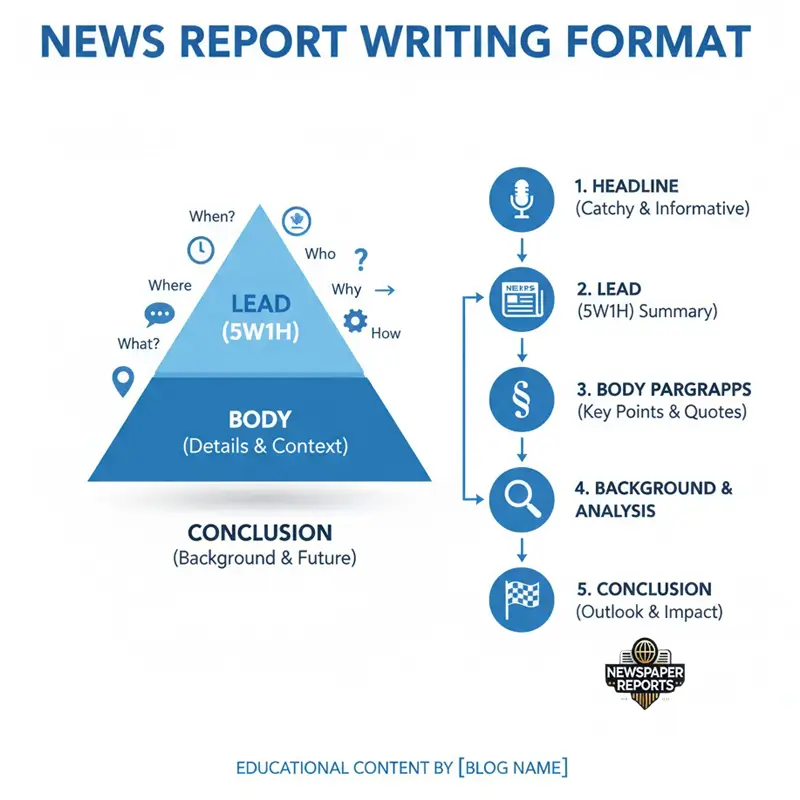How to Write a News Report: A Step-by-Step Format Guide for Beginners
Meta Description: Learn the standard news report format with our step-by-step guide. Master the inverted pyramid, write compelling headlines and leads, and craft accurate, unbiased reports. Perfect for students and journalists.

Introduction to News Report Writing
Writing a compelling news report is a fundamental skill for journalists, students, and content creators. Unlike an essay or an opinion piece, a news report follows a strict structure designed to deliver facts quickly, clearly, and objectively. Mastering this format ensures your reader gets the most critical information first, which is exactly what search engines and readers value.
The Foundation: The Inverted Pyramid
The inverted pyramid is the cornerstone of news writing. It means presenting the most crucial information at the top and then providing supporting details in descending order of importance.
Inverted Pyramid Structure:
- Top (Broadest Part): The most vital information (Who, What, When, Where, Why, How)
- Middle: Important details, context, quotes from sources, and background information
- Bottom (Narrowest Point): General background, tangential information, or less critical details
The Standard News Report Format (Step-by-Step)
1. The Headline (Title)
The headline is the first thing a reader sees. It must be accurate, engaging, and concise.
Example: Writing a Newspaper Report: A Complete Guide
2. The Byline
This line credits the author of the report.
Format: By [Your Name], Staff Reporter
3. The Dateline
The dateline specifies the city and sometimes the date from which the report was filed.
Format: CITY, State —
Example: AUSTIN, Texas —
4. The Lead (or Lede)
The lead is the first paragraph—arguably the most important part of your report. It must hook the reader and answer the 5 Ws and 1 H as succinctly as possible.
Example Lead:
"The Lincoln High School robotics team clinched first place at the National STEM Challenge in Washington D.C. on Saturday, securing a $50,000 grant for their innovative solar-powered robot."
- Who: Lincoln High School robotics team
- What: Won first place
- When: Saturday
- Where: Washington D.C.
- Why: Their innovative solar-powered robot
- How: By competing in the National STEM Challenge
5. The Body
The body of the report elaborates on the information introduced in the lead. It follows the inverted pyramid structure.
6. The Conclusion
The conclusion in a news report is not a summary of your opinion. It should include less critical details and a forward-looking statement.
News Report Template
HEADLINE
A Catchy and Informative Title
By [Your Name]
[CITY, State] — [Your compelling lead paragraph that answers the 5 Ws and 1 H.]
[Your second paragraph with essential details and a strong quote from a key source.]
[Your third paragraph with further explanation, context, or background information.]
[Your fourth paragraph with additional quotes or details from other sources.]
[Your concluding paragraph with final, less critical information or a forward-looking statement.]
Essential Tips for a Professional News Report
- Maintain Objectivity: Report the facts without inserting your personal opinion
- Use the Active Voice: It makes your writing more direct and vigorous
- Attribute All Information: Always state your sources using phrases like "according to" and "said"
- Write Concisely: Use short sentences and paragraphs
- Fact-Check Meticulously: The credibility of your report depends on its accuracy
Conclusion
By following this structured format, you can produce clear, credible, and engaging news reports that effectively inform your audience and meet the highest standards of digital journalism. Remember to always verify your facts and maintain journalistic integrity in every report you write.
Frequently Asked Questions
What is the most important part of a news report?
The lead (or lede) is the most important part of a news report. It's the first paragraph that must hook the reader and answer all the essential questions: Who, What, When, Where, Why, and How. A strong lead determines whether readers will continue with the rest of the article.
How long should a news report lead be?
An ideal news report lead should be concise, typically between 25-35 words. It should deliver the core information efficiently without unnecessary details. The goal is to provide the most crucial facts in the first 1-2 sentences to immediately inform the reader about the main story.
What is the inverted pyramid structure in news writing?
The inverted pyramid is a fundamental structure in news writing where the most important information appears at the top, followed by supporting details, and ending with general background. This approach ensures readers get the essential facts first and allows editors to cut from the bottom if space is limited without losing critical information.
Why is objectivity important in news reporting?
Objectivity is crucial in news reporting because it maintains credibility and trust with readers. It means presenting facts without personal bias, opinions, or emotional language. Objective reporting allows readers to form their own opinions based on verified information, which is essential for ethical journalism and informed decision-making.
What are the key differences between news reports and opinion pieces?
News reports present factual information objectively without the writer's personal views, follow the inverted pyramid structure, answer the 5W1H questions, and attribute all information to sources. Opinion pieces express the writer's personal perspective, use persuasive language, present arguments to convince readers, and may not follow a strict factual structure.
